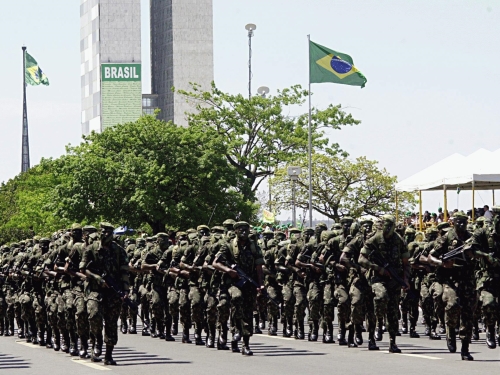
This article was originally published by Strife on 9 February, 2015.
Earlier this year, Dilma Rousseff replaced the chiefs of the armed forces for the first time as President of Brazil. The most anticipated was her pick for the influential position of Army Commandant. Rousseff’s choice raised a few eyebrows because she broke with the established practice of appointing the most senior officer for the job. It unexpectedly fell to candidate General Eduardo Dias da Costa Villas Bôas, just third in terms of seniority, to lead a fighting force of nearly 190,000 active personnel. With eight years ahead as the most senior commander of Brazil’s military, Villas Bôas will have to address several challenges if he expects to cement Brazil’s status as a major world power.
The first challenge is the budget wars. Facing sluggish growth, mounting inflation and falling investor confidence, President Rousseff appointed University of Chicago-trained economist Joaquim Levy as Finance Minister. Dubbed “Scissor-hands” Levy, budget slashing and austerity measures are the order of the day. General Villas Bôas will have a hard time securing the necessary funds for the Army’s modernisation projects. Its anti-aircraft and cyber-defence systems are outdated. New Astros 2020 multiple rocket launchers and Guarani armoured personnel carriers require billions of dollars until most components can be manufactured locally. Procedures are underway to transform most motorised infantry into mechanised brigades. Border satellite surveillance SISFRON, currently at pilot program phase, is expected to be fully operational by 2021 at a cost of $4.6 billion dollars.
The second challenge is to achieve a reasonable level of inter-operability between Army, Navy, and Air Force. Traditionally, each of the services has been managed as an autonomous fiefdom. Decades with no permanent top-level coordinating organs have generated military branches with a tenuous unity of command. The Ministry of Defence dates from 1999 while the office of the Joint Chiefs of Staff is an even more recent creation, from 2010. Hardware acquisitions and training are an entirely decentralised affair. Regional ground commanders are hesitant of integrating with Navy and Air Force counterparts, suspecting that the Army might lose its service distinctiveness. Even today, it could be reasonably argued that Brazil runs three parallel armed services.
As leader of Ground Operations Command (COTER), General Villas Bôas has complained that joint training is restricted to annual exercises for junior officers and sporadic division-level war games. Partly to address this issue, the Ministry of Defence is already planning to expand the magnitude of land-based Operação Amazônia and seaborne Operação Atlântico.
Brazil’s sudden shift towards inter-operability springs from the 2008 National Strategy of Defence (NSD); which represented the first ever concerted effort between civilian and military officers in developing a viable national defence strategy. It is based on the premise that Brazil requires reasonable levels of territorial security before it can play a larger role in global affairs.
The NSD recognises that Brazil might face a hostile extra-regional power or alliance of superior military strength (a not so discreet reference to either the United States or NATO) encroaching on its borderland and seaways. In such a scenario, an Army retaining a frontal-assault and concentration of firepower model from the World War II era – the last time Brazil saw full-scale military action – would prove unsuccessful. It would lack the necessary agility for exploiting brief windows of opportunity and vulnerabilities presented by an adversary in mid-power projection. What the NSD envisions is a fighting force capable of carrying out decentralised operations. To prevail in such a scenario, the NSD recognises that both joint strategic planning at the top and tactical coordination at the theater of operations level are essential. How this ambitious scheme can be achieved without even the existence of a joint force training centre is unclear.
Finally, the Army faces the arduous challenge of overhauling its defence perimeter. Since independence in the 19th century, Brazil’s main rival has been Argentina, its southern neighbour. As a result, most of its combat units were located close to the Argentine border. Yet by the turn of the 20th century the countries were close partners, causing Brasilia’s defence priorities to shift.
Heavily influenced by Michael T. Klare’s resource war literature, civilian and military policymakers identified the Amazon rainforest, covering most of the centre and north of the country, as a major defence liability. They worry that its petroleum deposits and mineral wealth might attract unwarranted attention from foreign powers. Worse still, they believe that Brazilian military capabilities situated in the isolated Amazonian region are not up to the task of defending the area because they remain scattered and inchoate. Villas Bôas has gone on record saying that the Amazon “is not integrated with the rest of the country” and that current budgetary allocations for armed forces in the area are inadequate.
To rectify this shortcoming, the NSD suggests that the Army must strengthen its presence in the Amazonian region. Relocation of military units from the south, the activation of a new Northern Military Command and the creation of more jungle infantry battalions are among the policies put forward. However, institutional inertia is not easily reversed. The Army’s budget process is in a balancing act between complying with the NSD Amazon refocus guidelines and funding its pet acquisition projects.
As former chief of the 1st Jungle Infantry Battalion and the Amazonian Command, Villas Bôas breaks with a tradition of Army chiefs who made their careers in the south and the east of the country. Displaying a clear understanding of NSD defence priorities, his appointment suggests that Brazil’s army might be on the cusp of a transformation.
Pablo Scuticchio is an International Politics graduate student at San Andrés University in Buenos Aires, Argentina. He is interested in Latin American defence and strategic studies. He can be reached at pscuticchio@gmail.com.
For more information on issues and events that shape our world, please visit ISN Security Watch or browse our resources.

